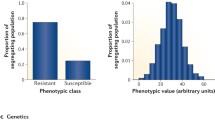Abstract
This Position Paper was prepared by members of the Task Force on Global Food Security of the International Society for Plant Pathology. An objective approach is proposed to the assessment of the potential of genetic modification (GM) to reduce the impact of crop diseases. The addition of GM to the plant breeder’s conventional toolbox facilitates gene-by-gene introduction into breeding programmes of well-defined characters, while also allowing access to genes from a greatly extended range of organisms. The current status of GM crops is outlined. GM could make an additional contribution to food security but its potential has been controversial, sometimes because of fixed views that GM is unnatural and risky. These have no factual basis: GM technology, where adopted, is widely regulated and no evidence has been reported of adverse consequences for human health. The potential benefits of GM could be particularly valuable for the developing world but there are numerous constraints. These include cost, inadequate seed supply systems, reluctance to adopt unfamiliar technology, concern about markets, inadequacy of local regulatory systems, mismatch between research and growers’ needs, and limited technical resources. The lower cost of new gene-editing methods should open the practice of GM beyond multinational corporations. As yet there are few examples of utilization of GM-based resistance to plant diseases. Two cases, papaya ringspot virus and banana xanthomonas wilt, are outlined. In the developing world there are many more potential cases whose progress is prevented by the absence of adequate biosafety regulation. It is concluded that there is untapped potential for using GM to introduce disease resistance. An objective approach to mobilizing this potential is recommended, to address the severe impact of plant disease on food security.
Similar content being viewed by others
Notes
** At present, the costs are such that the choice of GM for disease management in developing countries should be critically compared with alternative strategies for cost effectiveness. The products of commercial investment may however be locally available: for example the African Agricultural Technology Foundation introduces genes donated by multinationals into African varieties and provides farmers with assistance in using them (Delmer et al. 2003). The lower cost of new gene-editing methods should open the practice of GM beyond multinational corporations, reducing the constraint to focus on major crops and increasing the scope for small companies and academic researchers to develop GM cultivars (Ledford 2015).
References
Adenle, A. A., Moris, E. J., & Parayil, G. (2013). Status of development, regulation and adoption of GM agriculture in Africa: views and positions of stakeholder groups. Food Policy, 43, 159–166.
Bailey, R., Willoughby, R., & Grzywacz, D. (2014). On trial: agricultural biotechnology in Africa. Chatham House Research Paper: Energy, Environment and Resources July 2014, 1–26.
Bennett, D. J., & Jennings, R. C. (2014). Successful Agricultural Innovation in Emerging Economies: New Genetic Technologies for Global Food Production. UK: Cambridge University Press.
Collinge, D. B. (Ed.) (2016). Plant pathogen resistance biotechnology. Hoboken: Wiley-Blackwell.
Collinge, D. B., Mullins, E., Jensen, B., & Jørgensen, H. J. L. (2016). The status and prospects for biotechnological approaches for attaining sustainable disease resistance. Plant Pathogen Resistance Biotechnology, 1–20. Hoboken: Wiley-Blackwell.
Delmer, D., Nottenburg, C., Graff, D., & Bennett, A. (2003). Intellectual property resources for international development in agriculture. Plant Physiology, 133, 1666–1670.
European Commission (2015). Restrictions of geographical scope of GMO applications/authorisations: Member States demands and outcomes. http://ec.europa.eu/food/plant/gmo/authorisation/cultivation/geographical_scope_en.htm.
Evenson, R. E., & Gollin, D. (2003). Assessing the impact of the green revolution, 1960 to 2000. Science, 300, 758–762.
FAO (2015). The Millennium Development Goals Report 2015. http://www.un.org/millenniumgoals/2015_MDG_Report/pdf/MDG%202015%20rev%20(July%201).pdf
Fermin, G. M., Castro, L. T., & Tennant, P. F. (2010). CP-transgenic and non-transgenic approaches for the control of papaya ringspot: current situation and challenges. Transgenic Plant Journal, 4, 1–15.
James, C. (2015). Global Status of Commercialized Biotech/GM Crops: 2015. ISAAA Brief no. 51. International Service for the Acquisition of Agri-biotech applications, Ithaca, New York.
Ledford, H. (2015). CRISPR, the disruptor. Nature, 522, 20–24.
National Academies of Sciences, Engineering, and Medicine (2016). Genetically Engineered Crops: Experiences and Prospects. Washington, DC: The National Academies Press 388 pp.
Oerke, E. C., & Dehne, H. W. (2008). Safeguarding production losses in major crops and the role of crop protection. Crop Protection, 23, 275–285.
Qaim, M. (2015). Genetically modified crops and agricultural development. Palgrave Studies in Agricultural Economics and Food Policy. London: Palgrave Macmillan.
Sanvido, O., Romeis, J., & Bigler, F. (2007). Ecological impacts of genetically modified crops: ten years of field research and commercial cultivation. Green Gene Technology, Advances in Biochemical Engineering/Biotechnology, 107, 235–278.
Suzie, K., Julian, K.-C. M., & Pascal, M. W. D. (2008). Genetically modified plants and human health. Journal of the Royal Society of Medicine, 101, 290–298.
Tester, M., & Langridge, P. (2010). Breeding technologies to increase crop production in a changing world. Science, 327, 818–822.
Tripathi, S., Suzuki, J., Ferreira, S., & Gonsalves, D. (2008). Papaya ringspot virus-P: characteristics, pathogenicity, sequence variability and control. Molecular Plant Pathology, 9, 269–280.
Tripathi, L., Mwangi, M., Aritua, V., Tushemereirwe, W. K., Steffen, A., & Ranajit, B. (2009). Xanthomonas wilt: a threat to banana production in east and Central Africa. Plant Disease, 93, 440–451.
US Census Bureau (2015). US Census Bureau International Database. https://www.census.gov/population/international/data/idb/worldpopinfo.php
World Health Organization (2014). Frequently asked questions on genetically modified foods. http://www.who.int/foodsafety/areas_work/food-technology/faq-genetically-modified-food/en/
Author information
Authors and Affiliations
Corresponding author
Additional information
This Position Paper was prepared by members of the Task Force on Global Food Security (http://www.isppweb.org/foodsecurity_tf.asp) of the International Society for Plant Pathology.
A Position Paper of the Task Force on Global Food Security is a factual summary of the principal aspects of a topic, from the perspective of plant pathology, to present a position from which the merits and drawbacks of particular issues that arise within that topic can be rationally discussed.
Rights and permissions
About this article
Cite this article
Scott, P., Thomson, J., Grzywacz, D. et al. Genetic modification for disease resistance: a position paper. Food Sec. 8, 865–870 (2016). https://doi.org/10.1007/s12571-016-0591-9
Received:
Accepted:
Published:
Issue Date:
DOI: https://doi.org/10.1007/s12571-016-0591-9




